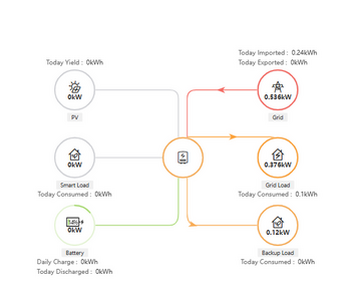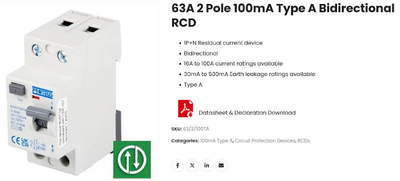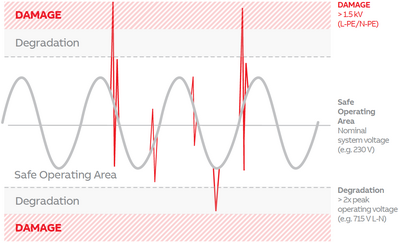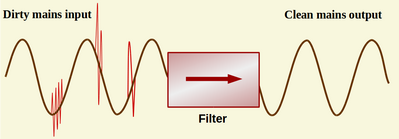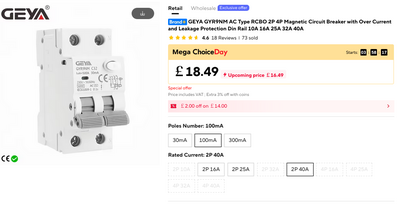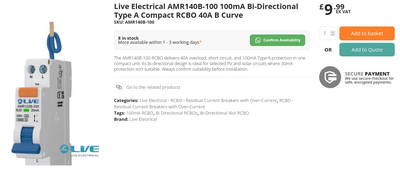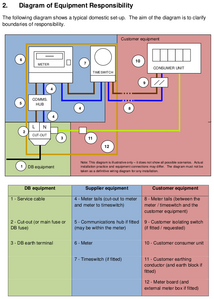Buying large amp bidirectional RCD and RCBO
I recently bought a 8k hybrid inverter.
The vendor confirmed that in order to connect it to the consumer unit, cables and protection devices needed to be rated x1.25 the maximum current that the inverter would receive or send. These are typically MCBs (preferably use RCBOs that also enable RCD function).
The following diagram shows what is involved.
In my case, two cables were planned to be buried in a wall and so they would need RCD protection (which is preferably achieved using RCBOs):
- one is used to supply power to backup loads
- the second is used to provide grid power to the inverter. It is also used to provide power to the house and/or grid, when there is production on site. So this requires devices that are not damaged when subjected to bi-directional flows.
In SE England, the shops that you can go and buy them include these that are open extended hours:
- screwfix.com
- toolstation.com
- tlc-direct.com
Additionally there are specialised shops like CEF, that are only open during working hours, so you may prefer delivery in 2/3 days.
The manufacturer advises for 100ma RCDs to be used. But in case your local electricity grid is not rock-steady (like in my case), the inverter cleans the power before using it. This often results in frequent triggering of the RCD. The manufacturer may recommend 300ma or higher RCDs. If PV is produced, this can also result in the need to use less sensitive (higher ma) devices.
In my case, the amp rating of devices required was 62.5 Amp for the grid and 45.5 for the backup. But given these inverters are available in 10Kw+ sizes, higher capacity may be needed.
Finding suitable devices proved time consuming as you find the protection level originally expected needs to be adjusted. Additionally, in some cases, RCBOs of the required rating were not available and so RCDs would have to be combined with MCBs.
Over to @transparent and others to add to my summary description and identify suitable options and example shops.
16kWh Seplos Fogstar battery; 8kW Solis S6-EH1P8K-L-PLUS hybrid inverter; Ohme Home Pro EV charger; 100Amp head, HA lab on mini PC
There won't be many RCBOs with a 100mA trip rating because that's stipulated for fire protection, rather than human safety.
However, Proteus do manufacture a 63A rated Type-A RCBO here in the UK.
CEF are the usual suppliers for Proteus trips, but other professional electrical outlets may order them if you ask specifically.
This isn't the sort of item you'd expect to source through a retail chain such as Toolstation (Travis Perkins Group), Screwfix and B&Q (Kingfisher Group).
Depending on the required cable length and the method of burial in the wall, I would expect the required mains cable size to be 10mm² or 16mm²
For current capacity above 63A you'd need to use a separate RCD (Type-A) and an MCB selected according to your cable size.
The RCD would need to be able to carry at least the same current as the MCB, and 125A would be fine.
The RCD and MCB will be 3-phase of course.
An inverter requiring that much current wouldn't be permitted by the DNO on a single-phase supply.
The other major manufacturer of such high-current RCDs and RCBOs is Chint.
They manufacture in China.
Their products are available here in UK,
or at reduced price by ordering direct from the Chint Electrical store on the AliExpress platform.
Delivery from China is typically 8-10 days at the moment.
Save energy... recycle electrons!
Exactly @transparent , this type of RCBOs are not easily available. We are only considering a 8k inverter and it is only available from a couple of shops. And I did not find many brands.
There are other ways to meet regulations. For example, to make sure all the cables are surface mounted and inside ducting. An electrician can advise on what may work in each case. Essentially that would enable use of double or triple pole MCBs that are very cheap (and commonly available for much higher Amps).
My 8kw inverter is single phase and is only expected to export 5kw. The rest of the capacity may be for consumption.
And before advising anyone to move a circuit from single phase to triple phase, I would need to understand the costs involved. If they are lucky to find anyone willing to put a ceiling on all the costs, that is great.
Otherwise, they need to be ready for the whole journey. @transparent may be able to expand on what this would typically involves.
16kWh Seplos Fogstar battery; 8kW Solis S6-EH1P8K-L-PLUS hybrid inverter; Ohme Home Pro EV charger; 100Amp head, HA lab on mini PC
Posted by: @batpredExactly @transparent , this type of RCBOs are not easily available.
It's the requirement to have 100mA earth-leakage tripping which makes your request more difficult to satisfy.
There are plenty of bi-directional Type-A RCBOs at 40A+ if the usual 30mA trip was acceptable.
I stopped looking once I'd find two products from reputable manufacturers with whom I've actually been in direct contact.
I wasn't anticipating that you'd use my recommendations as being indicative of the state of the market.
Posted by: @batpredThere are other ways to meet regulations. For example, to make sure all the cables are surface mounted and inside ducting.
Surface-mounted cables will have a higher current rating than those within ducting due to their ability to release heat into the surrounding air.
There are several online cable-size calculators which allow the input of such parameters, such as this one by TLC-Direct.
Posted by: @batpred... Essentially that would enable use of double or triple pole MCBs that are very cheap (and commonly available for much higher Amps).
Sorry, I don't follow that argument.
Double-pole MCBs are available for DIN-rail mounting in a consumer unit up to 125A,
But you'd still need a separate RCD to obtain any earth-leakage protection.
3-pole MCBs are for 3-phase supplies of course.
Posted by: @batpredAnd before advising anyone to move a circuit from single phase to triple phase, I would need to understand the costs involved.
I've just commented about that here on a topic about a Storage Battery problem.
Save energy... recycle electrons!
Posted by: @transparentPosted by: @batpredExactly @transparent , this type of RCBOs are not easily available.
It's the requirement to have 100mA earth-leakage tripping which makes your request more difficult to satisfy.
There are plenty of bi-directional Type-A RCBOs at 40A+ if the usual 30mA trip was acceptable.I stopped looking once I'd find two products from reputable manufacturers with whom I've actually been in direct contact.
I wasn't anticipating that you'd use my recommendations as being indicative of the state of the market.
I do not understand the reason for the confusion.
I did not see more than a couple of 100ma bi directional RCBOs in the UK market, and of low amps. And as I mentioned, the grid power is very dirty in my area. So the Solis requires the ma to be higher than 100ma.
In essence, they are not easily available.
My advice is for anyone to consider alternatives that can meet the regulations. Another that electricians mentioned is to use armoured cable. This is more expensive than normal cable but it may provide predictability for the project. This may be of significant value to many.
Posted by: @transparentPosted by: @batpredAnd before advising anyone to move a circuit from single phase to triple phase, I would need to understand the costs involved.
I've just commented about that here on a topic about a Storage Battery problem.
You seem to have included the wrong link, I could not find any figures. Hopefully your estimate is not close to what I was given - £3200 to install the battery and inverter?
When I said "costs", I mean what the customer has to pay.
16kWh Seplos Fogstar battery; 8kW Solis S6-EH1P8K-L-PLUS hybrid inverter; Ohme Home Pro EV charger; 100Amp head, HA lab on mini PC
It's the correct link @batpred and here's the relevant text:
The only costs involved with the DNO upgrading a dwelling to 3-phase are those charged by your own electrician to divide the household circuits across the phases.
It's impossible to estimate that unless the present arrangement of consumer unit(s) and circuits is known.
Your estimate of £3200 for an electrician to install a battery and inverter depends on what is required to run cabling back to the consumer unit.
That's specific to the dwelling and can't be assessed here on an open forum without detailed knowledge of the property.
Posted by: @batpredAnd as I mentioned, the grid power is very dirty in my area. So the Solis requires the ma to be higher than 100ma.
I don't follow that logic, but I can make two useful observations:
a: there shouldn't be any correlation between higher-frequency components being present on the 50Hz mains supply and whatever filters are incorporated into an inverter.
Those inbuilt filters may well result in a small amount of current leakage to ground, but the leakage current is the same irrespective of the quality of the mains sinusoidal waveform.
b: It is usually the case that higher-frequency noise is imposed onto the 50Hz mains supply by AC/DC switching electronics, such as found in the inverter.
In other words, the inverter is more likely to be the culprit, not the device being adversely affected.
In rare instances transient spikes are sufficiently large that they can cause degradation of insulation within a device,
or arcing within electronics.
There are transient suppressors which can remove such high frequency spikes and harmonics.
They are very often found in medical apparatus, for obvious reasons!
Since I have a number of (different types of) inverters, I've installed transient suppressor filters in reverse on their mains supplies.
That means I'm removing spikes which might be created within the inverter electronics, to prevent them propagating through the consumer unit to other household circuits.
The above photo was taken whilst that particular Consumer Unit was still being assembled.
The M4 terminals on those filters were fitted with tamper-resistant insulated caps before the remainder of the trips were installed onto the DIN rail.
Save energy... recycle electrons!
Posted by: @batpredI did not see more than a couple of 100ma bi directional RCBOs in the UK market, and of low amps.
Quite possibly...
... and I've identified two more above, and provided the URLs so you can check their specifications.
Let me add yet another couple of brands to this growing list of RCBOs with 100mA leakage-current rating:
Geya is another Chinese-based manufacturer, and also well known to me.
The above listing can be found here on AliExpress, and you can choose from three alternatives for the earth-leakage trip current.
Geya also make DC MCBs, which can be used between a battery and an inverter, for example.
They are technically competent, and provide good customer service.
They don't advertise their complete range on AliExpress.
If you can't find what you want, click the button to send a Message to Seller and ask them (in English).
Next, there's this particularly cheap RCBO badged 'Live'' and available from the UK-based online reseller Electrical 4 Less.
I'm not finding it particularly difficult to identify where these RCBOs are available from.
But they're not 'consumer devices', and you'd normally expect your electrician to get them for you through his trade outlets.
Save energy... recycle electrons!
Posted by: @transparentIt's the correct link @batpred ...
The only costs involved with the DNO upgrading a dwelling to 3-phase are those charged by your own electrician to divide the household circuits across the phases.
Ok, but it would be helpful to get a figure. Perhaps assuming a standard arrangement of consumer unit(s) and circuits that a terraced house has?
Also I assume the dno is not responsible for making the areas where the new cable goes good.. so the cost to the consumer is more?
I am curious though about how electricity prices compare between 3 phase and single . Perhaps a new topic?
Posted by: @transparentPosted by: @batpredAnd as I mentioned, the grid power is very dirty in my area. So the Solis requires the ma to be higher than 100ma.
I don't follow that logic, ...
My dno's feed has a dirty neutral. Based on what Solis support said, when the inverter discharges that to earth, it causes triggering of rcbos.
When my installation finishes and I confirm the power in the g99, I will notify these issues to the dno. Hopefully they will fix it.
16kWh Seplos Fogstar battery; 8kW Solis S6-EH1P8K-L-PLUS hybrid inverter; Ohme Home Pro EV charger; 100Amp head, HA lab on mini PC
Posted by: @batpredI assume the dno is not responsible for making the areas where the new cable goes good
The following diagram is taken from the Meter Operator's Code of Practice guidance (MOCoPA)
When a dwelling is upgraded to 3-phase, your Energy Supplier coordinates with your DNO.
The devices on the blue and green sections of the diagram are changed together.
It has been the case in the past that some Energy Suppliers make a charge to install a 3ph Smart Meter.
However, if the work is being done based on a technical requirement from your DNO, then it's a safety issue, for which you shouldn't pay of course!
If your Supplier still tries to levy a charge under these circumstances, then telephone a rival supplier.
Tell them you'll move your account to them if they provide a 3ph meter.
That's a persuasive argument,
which you can then take back to your existing Supplier and tell them they're about to lose a customer!
Posted by: @batpredI am curious though about how electricity prices compare between 3 phase and single
The cost per kWh remains the same.
There isn't a different Tariff for householders with 3-phase domestic supplies.
3-phase Electricity Smart Meters operate under Vector Sum.
If your house is exporting to the grid on one phase, and importing on the other two, you are only charged for the difference between the phases.
Save energy... recycle electrons!
- 26 Forums
- 2,364 Topics
- 53.6 K Posts
- 274 Online
- 6,027 Members
Join Us!
Worth Watching
Latest Posts
-
RE: New Fogstar 15.5kWh upright solution
@transparent My conclusion is as you have noted, tha...
By Bash , 8 minutes ago
-
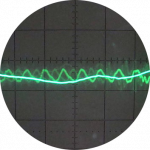
RE: Setback savings - fact or fiction?
Exactly. And at the same time, the house remains in ove...
By cathodeRay , 1 hour ago
-
RE: Grant Aerona: Is there a setting to keep the 2-port valve open during pump blockade
@rhiannon Welcome to the forums and feel free to ask an...
By JamesPa , 2 hours ago
-

That makes sense to me,although we don't know what the ...
By Transparent , 2 hours ago
-
RE: Mitsubishi Ecodan R290 10kW performance
And to you too. Wishing you a very enjoyable festive s...
By Sheriff Fatman , 3 hours ago
-

RE: External pipework insulation
They do? But that isn't apparent from the photos we'r...
By Transparent , 5 hours ago
-
RE: My Powerwall 3 Consumes 3-4 kWh/Day in Self-Consumption: Is This Normal?
@editor Thank you so much for looking into this for me ...
By Caron , 5 hours ago
-
RE: Solis S6-EH1P8K-L-PLUS – Why I Chose It and What I’ve Learned So Far
I've been looking at the S6-EH1P8K-L-PLUS, but put off ...
By energy9165 , 6 hours ago
-
RE: Speedcomfort radiator fans
Too expensive IMHO for a whole house, at this point do ...
By JamesPa , 6 hours ago
-

RE: Say hello and introduce yourself
@velcro welcome to the forums. Please feel free start a...
By Mars , 19 hours ago
-
Daikin EDLA11D3V3 DHW Settings
I have a newly installed EDLA11D3V3 which I'm still get...
By Velcro , 20 hours ago
-

@jamespa I have found that it comes as a shock when we ...
By Toodles , 21 hours ago
-

RE: Need Help Optimising My Rushed ECO4 Install: 12kW Bosch Heat Pump
Hi @mickamills . Welcome to the forum. It sounds like...
By bontwoody , 23 hours ago
-
RE: Midea ASHP – how to set weather compensation
@curlykatie did you get sorted with this?
By MickaMills , 24 hours ago
-
RE: Octopus Cosy Heat Pump Owners & Discussion Thread
The FT levels off at either the set point OR the minimu...
By AndrewJ , 2 days ago
-
RE: MyVaillant Connect Regular Disconnect
Thanks. Yes, if the time is consistently 11pm every nig...
By buckwem , 2 days ago
-
RE: Who's your electricity provider and what's your tariff?
@transparent Thanks, this helps. Could it be that St...
By Batpred , 2 days ago
-
RE: Clivet ASHPs and weather compensation
Simon did share a lot of very helpful advice. On furthe...
By ambris , 2 days ago

